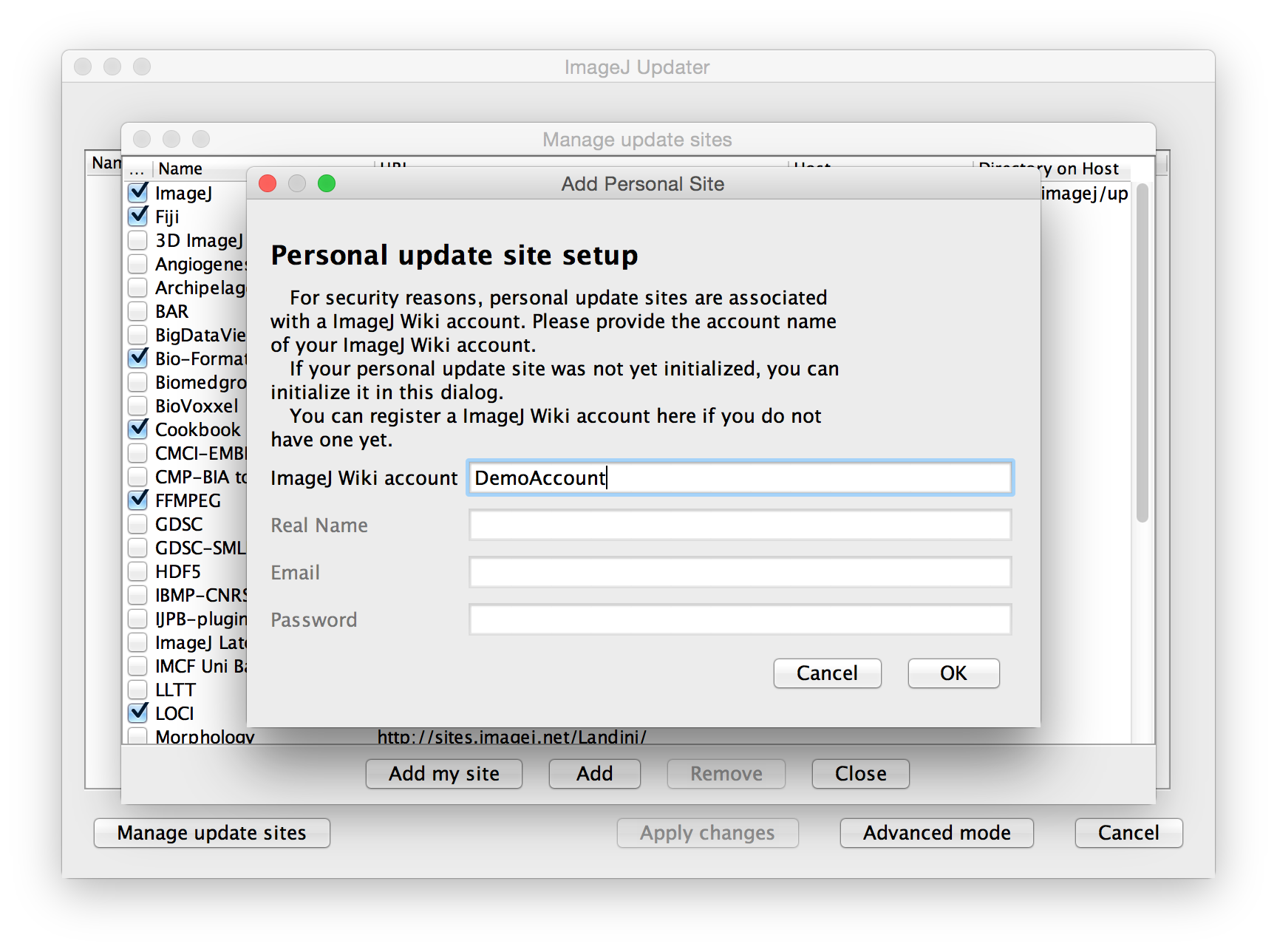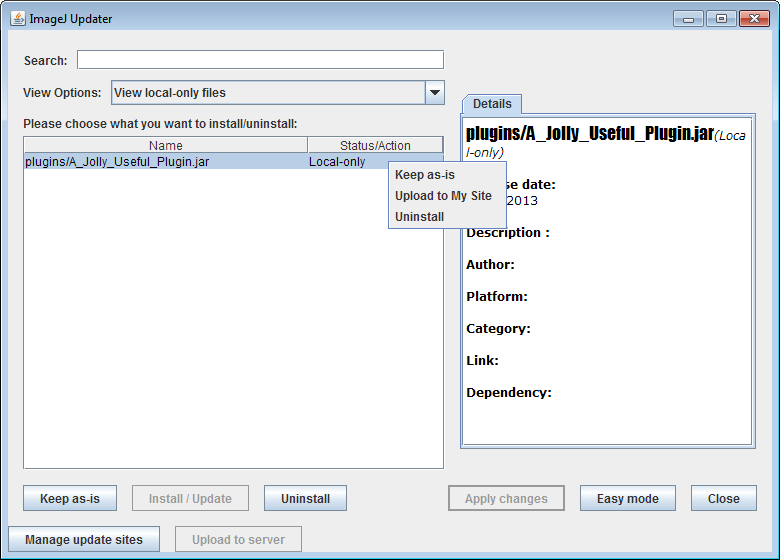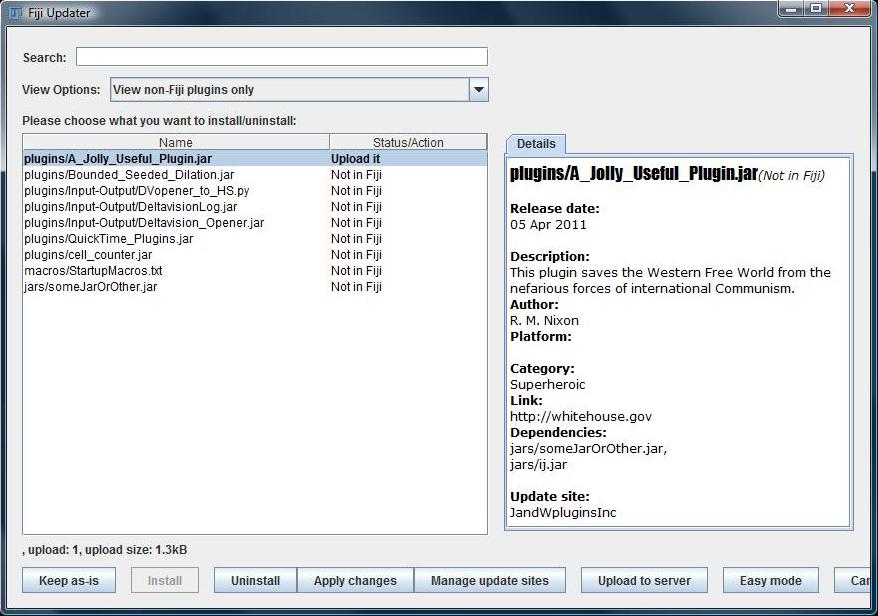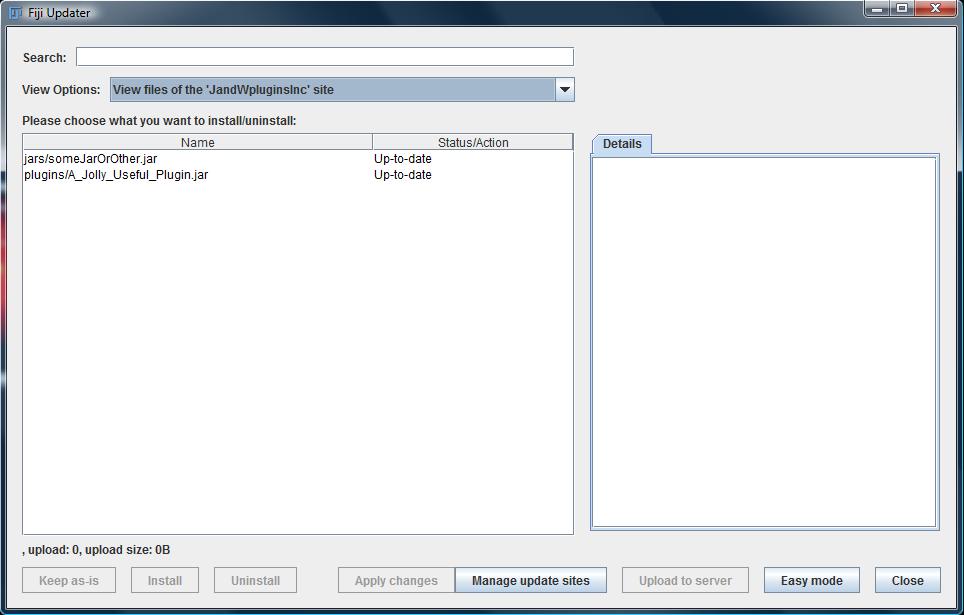How to set up and populate an update site
| Update Sites | |
|---|---|
| Introduction | |
| Following an update site | |
| Creating your own update site | |
| Terms of Service for personal update sites | |
| Automatically upload your site | |
| Uploading to core update sites | |
| List of update sites | |
| Update site FAQ | |
Contents
Introduction
This tutorial explains how to set up a website to distribute your plugins. It assumes that your plugins are correctly installed in your local ImageJ setup.
Rationale
See the Distribution page for a discussion of the benefits of update sites and how they fit in to plugin development.
Add your personal update site
By far the easiest method to provide your macros, scripts and plugins to other users, letting them keep up-to-date in the most convenient manner, is to set up your personal update site.
A personal update site is hosted on https://sites.imagej.net/<imagej-wiki-account>. If you do not have an ImageJ Wiki account yet, no need to worry, you can register one while setting up your update site.
First of all, create a wiki account on https://imagej.net.
Please note, that the password for the corresponding update site is NOT the one for your wiki account. In order to set your update site password, use the link at the bottom of the wiki or click here.
start the updater with Help › Update and click on the Manage update sites button:
Specifying your existing ImageJ Wiki account
Enter the name of that account and click OK:
If your upload password (separate from your wiki password) was not initialized, you will then be asked to provide your wiki password, which will be used to initialize your upload password. The two passwords can differ. This can be source of confusion during setting up of the update.
You can also manually change or initialize your upload password.
Dedicated plugin update sites
Rather than having a single update site for many plugins, it is highly advised to set up dedicated update sites for each plugin that could be of interest to the community.
Such dedicated update site can have a more intuitive name.
A given user/wiki account can own several update sites. To request a new update site for your user account, post your request on the forum (see related post), or on the ImageJ Gitter.
Group update site
In addition to personal update sites, it is possible for groups of people to share an update site.
To create such an update site, post on the Image.sc Forum, or in the imagej Gitter channel, requesting the creation of the site on sites.imagej.net, including the desired name of the site, as well as the wiki usernames to be granted upload permission to the group update site. An administrator will then create the site skeleton and grant those users upload permission to the new site.
Adding an update site on your own server
If you have an own server or web space with WebDAV, SFTP or SSH access, you can create a directory in that web space and initialize it as an update site, too. Just call the updater with Help › Update and click the Manage update sites button:
Now press the Add button, provide a nick name for your update site, the URL of your web space, and upload information.
The upload information depends on the protocol available for uploading:
| Protocol | Host | Directory on Host |
|---|---|---|
| WebDAV | webdav:, or webdav:<webdav-user> | . |
| SFTP | sftp:<sftp-user>@<sftp-host> | <absolute-path> |
| SSH | ssh:<ssh-user>@<ssh-host> | <absolute-path> |
In case you want to use an SFTP/SSH server, it must have an empty, public web accessible folder where you intend to publish your updates. The ImageJ updater will not create that empty folder.
Example: Let's assume you have SFTP access to a machine known as imagej.example.org to the internet, and let's assume that you have a user account myself that has write access to the path /var/www/my-update-site/ on that machine that is served via http://imagej.example.org/my-update-site/. Then the line you need to add might look like this:
| Name | URL | Host | Directory on Host |
|---|---|---|---|
| My Update Site | http://imagej.example.org/my-update-site/ | myself@imagej.example.org | /var/www/my-update-site/ |
If the update site has not been initialized yet (i.e. if nobody else has initialized that site yet), you will see a dialog like this:
Just click OK and let the updater upload an empty file index (it is stored in the file db.xml.gz which is also called the database in the documentation of the updater).
Uploading files to your update site
Note: you cannot simply copy files to your web space; the updater would miss all kinds of important information, and consequently refuse to accept that update site. You need to let the updater handle the file uploading.
Start the updater and check your update site
First, start the updater:
Click on the Manage update sites button and verify:
- Your update site is present and enabled
- The Host column of your update site contains your user name, in the form:
webdav:<WikiUsername>
For example:
Once your login information is set you can Close the update site window.
Prepare your files for upload
Click on the Advanced mode button and set the view options to see your plugins:
- If your have never uploaded your plugins, select View local-only files
For .ijm macro, the files must be located in the macro or scripts folder (or any subfolder in it).
For .py scripts, they can be either in the Jars/Lib or scripts folder (or any subfolder).
Out of those folder, the updater might not see them.
- If you are uploading new versions of your plugins, select View locally modified files only
In this case, the plugin we'll be uploading is contained in A_Jolly_Useful_Plugin.jar.
Select the file to upload, click under the Stats/Action column, or right-click (on MacOSX, ^ Ctrl+click) in any column, for the context menu and select Upload to <update site name>.
Modifying Dependencies
When a plugin is selected, a Details panel becomes available. The plugin's dependencies, e.g. ij.jar and someJarOrOther.jar, are automatically determined by the updater. Hence if you require 3rd party packages for your plugin you can place them into the jars folder of ImageJ and the updater will automatically upload them to the site.
You can also manually enter or edit any information in the Details panel:
Upload your files
Finally, click Apply changes (upload) to upload your plugin to the server and allow others to access it. If you have dependencies that are not part of ImageJ, the updater will ask you if you want to upload that jar as well. Finally, you will be asked for your login credentials again and the files will be uploaded to the server.
Check that your plugins are now registered as ImageJ plugins by selecting the View files of the '[your site name here]' site view option:
That's it - you're done. Now, anyone who wants a copy of your plugins merely needs to add your update site to the Update manger via the URL you specified, and your plugins will be downloaded and updated in their ImageJ installations just like the standard ImageJ plugins.
For even more visibility and practicability, you can ask to have your update site listed in the Fiji Updater (see section below).
Publishing your update site
If you want your update site to be listed in the ImageJ update manager, follow the instructions at this page : list of update sites.
Further Reading
For additional information on common topics regarding update site maintenance, please see the update site FAQ.






